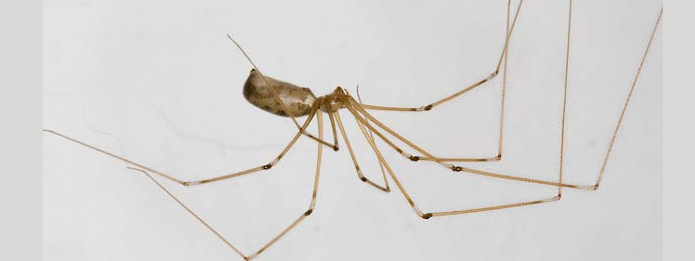
A few spiders in your home are not cause for alarm. Spiders are mostly harmless, and having them around may be beneficial to the ecosystem because they feed on insect pests. However, if spiders seem to be overrunning the entire house, it may be necessary to seek out professional spider removal.
There are at least 1,000 species of spiders found in Canada. Some are relatively rare, while others are more common. Here is a guide to the five spider species you are most likely to encounter, especially in Canadian homes.
1. Cellar Spiders
Cellar spiders are also known as daddy longlegs and with good reason. The length of each of their legs may be longer than the length of their entire bodies by a factor of five or six. They like to take up residence in areas of the home that are dark and humid, which may include basements or crawl spaces as well as cellars.
Though creepy-looking with their long legs, cellar spiders are harmless and do not bite humans. They do, however, have an unusual habit of carrying their egg sacs in their mouths until the eggs hatch instead of attaching them to their webs as other spiders do.
2. House Spiders
House spider is actually a name given to several different Canadian species. You can recognize them by their extra-long pair of front legs compared to the other three pairs, but they may be different colours, including black, white, or brown.
Like cellar spiders, house spiders can eat other spider species in addition to insects. You are likely to find house spiders in dark corners and under furniture. They can bite, but it causes only minor redness and irritation. House spiders only bite in response to a perceived threat or if they are startled.
3. Wolf Spiders
Wolf spiders are so called because they actively hunt their prey instead of spinning a web to trap insects, as most other spiders do. They are most likely to enter human homes during the winter when the temperature drops and they need a place to get warm.
The bite of the wolf spider feels like a bee sting and produces similar effects. They only bite if trapped next to the skin or otherwise threatened. Wolf spiders are recognizable by the long hairs on their legs and bodies in patterns of black, brown, grey, and orange.
4. Black Widow Spiders
Black widow spiders are rare in Canada and are more likely to be found in adjacent outbuildings or crawlspaces than in people’s homes. However, the black widow is still worth mentioning because it is the only spider species on this list that can do serious harm to humans with its bite. The venom of the black widow spider can cause severe symptoms of muscle spasms and pain, abdominal cramps, accelerated heartbeat, and profuse sweating. While the bites are rarely fatal, symptoms can linger for weeks.
Fortunately, like most spiders, black widows only bite when threatened. They are easy to recognize by their round, shiny black bodies and the brightly coloured hourglass shape on the underside of their abdomens, usually red or orange. This is not always present, however, and it is not advisable to try flipping a spider over to see if you can find it.
5. Fishing Spiders
As implied by the name, fishing spiders feed on creatures that live in the water, including tadpoles, frogs, and even small fish. They are large spiders that actually have the ability to walk on water.
Fishing spiders resemble wolf spiders somewhat, but they are not as hairy and their eyes are of more uniform size. You are most likely to find fishing spiders in your home if you live near a body of water or have a swimming pool.
Spider Removal
If spiders are making a nuisance of themselves, contact Truly Nolen. We perform targeted treatments both inside and outside your home.